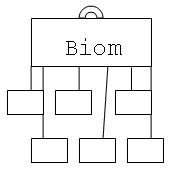|
BIOMES
LESSON PLAN
Key Vocabulary
Biomes, climate, terrain, flora, fauna, evergreen forest, desert,
rainforest, deciduous forest, grasslands, tundra
Lesson Materials
• Hangers
• Construction paper
• Crayons, scissors, pencils, glue, hole punch
• Fishing line
• Biome printables (3 copies of each per student)
• Flora and Fauna printable
• Books about biomes
Some great suggestions:
What is a Biome? (Bobby Kalman)
A World of Biomes Series (Philip Johansson)
Biome Atlases (Library Binding)
Biome Lesson Introduction
Read aloud a book about biomes to the class and ask the following
comprehension questions:
• What is a biome? (an environment)
• What are the six major biomes in the world? (tundra, evergreen forest,
deciduous forest, grasslands, rainforest, desert)
Explain to students that the biomes often have different types of animals
and plants, or fauna and flora, which have adapted to the environment.
Tell students that sometimes, the same animals and plants can live in more
than one biome.
Ask students:
• Could a polar bear live in a desert? Why or why not?
• What animal could live in a desert? Why?
Tell students that they will get a chance to find out more about the
different biomes because they will be researching and creating biome
mobiles.
Body
Model for students how to make the mobiles and write the steps on the
whiteboard.
Tell students that they will first research the different biomes and fill
out a Biome printable for each biome. They can use text books, trade books,
internet or other resources. Explain the different sections of the printable
and the definitions of terms (climate, terrain, etc.). Cut out the biome
cards (6 altogether).
Students will then use the
blank printables to draw a realistic picture
of the biome based on the facts they have collected. Students will then
color and cut out the animals and plants on the Flora and Fauna printable
and glue the animal and plant that best fit the biome onto the picture.
Tundra- polar bear, lichen
Deciduous forest-oak tree, owl or moose
Evergreen forest-pine tree, moose or owl
Desert-cactus, scorpion
Rainforest- palm tree, parrot
Grassland- zebra, sweet fennel |
Students can also draw their own plants and animals on their picture.
Students will then cut a piece of construction paper to mount the picture
and then glue the biome facts on the back of the construction paper.
Students should have six rectangles with pictures of the biomes on one side
and the corresponding fact card on the backside. Check students' work to
assess understanding of concepts.
Students can now create their biome mobile. They can cover the hanger
with construction paper and punch six holes in the top part. Student can
then punch holes in the top of their biome cards to attach the cards to
hanger with fishing line. Have students cut varying lengths of fishing line
so that the cards are staggered. Student can write "Biomes" or another title
for their mobile on the hanger part.

Closure
Ask students to share their mobiles with the class or in groups. These make
wonderful decorations in the classroom.
Extension Activities
• Have students create bulletin boards of each biome in the classroom. Blow
up the Flora and Fauna printable on a copy machine and put up the animals
and plants in the appropriate biome. Have students add their own plants and
animals as they learn about each biome.
• Students can use the Biome printables to make a biome mini-book. Use the
printables as fact cards for research or the pages for the book.
• On a map, have students identify the biome locations in a continent or the
world and create a bulletin board.
• Students can do oral reports or research projects on a particular biome in
groups.
• Students can write descriptive paragraphs about a particular biome, in
which they use their five senses to describe the environment.
 For more
teaching material, lesson plans,
lessons, and worksheets please go back to the InstructorWeb home page. For more
teaching material, lesson plans,
lessons, and worksheets please go back to the InstructorWeb home page.
|